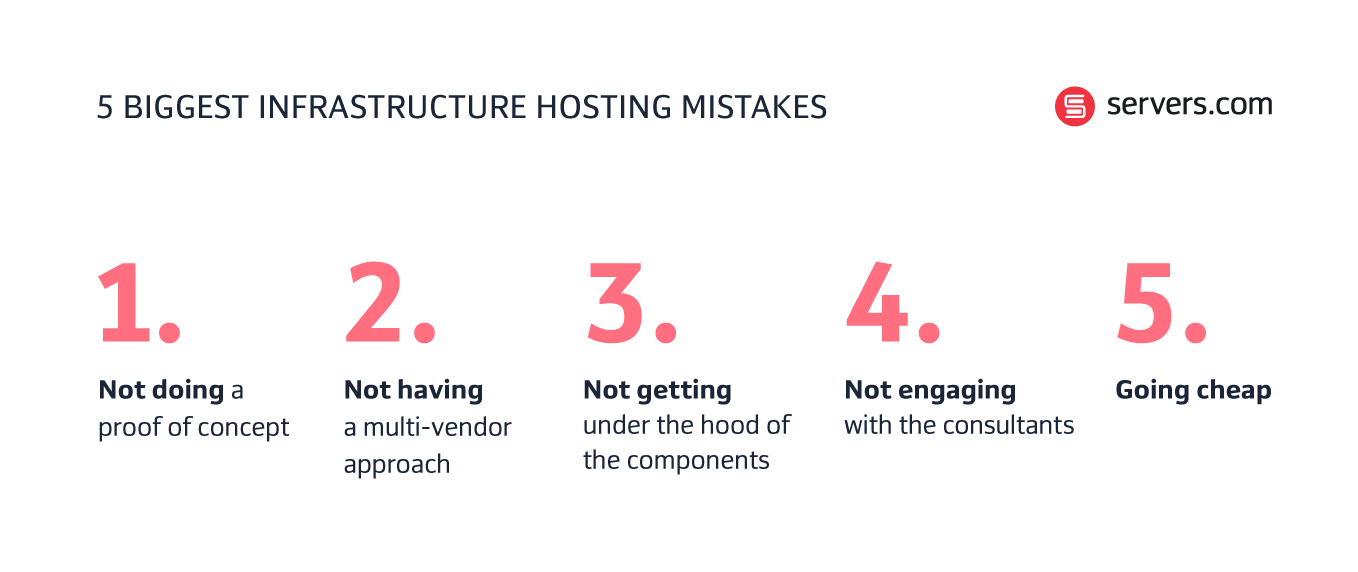

The decisions made around IT infrastructure today can make or break a company’s ability to sell to, service and build relationships with customers.
Downtime, in particular, can disrupt streaming, gaming, purchasing, trading and critical systems. According to IT leaders, infrastructure outages are the most likely source of disruption for their organization.
Mistakes made when it comes to infrastructure hosting are well documented in the media and social communities, and that kind of exposure can damage reputations. It also costs. Over two-thirds of outages cost companies more than $100,000 each time.
The key is to do everything possible to avoid challenges when it comes to infrastructure. And there are five big infrastructure hosting mistakes we see companies making time and time again.
In this blog, we explore what those mistakes are and how to avoid them.
But let’s first start with a quick reminder on what is infrastructure hosting.
Table of contents
Infrastructure hosting is the act or service of hosting a company’s IT infrastructure – servers, networking, storage – from a data center, either on the company’s premises, or remotely.
There are three main categories of infrastructure hosting:
Single-tenant bare metal servers that provide exclusive use of all server resources, including RAM, disk, CPU and bandwidth. They can be hosted in three different ways:
On-premises – the servers are housed in the company’s office building.
Co-location – a company rents space in a data center to house their infrastructure hardware, which they have purchased. Ongoing maintenance and management of the hardware is down to the company.
Infrastructure as a service (IaaS) – a company rents bare metal server resource from a dedicated server provider which provisions, deploys and maintains the infrastructure on behalf of the company.
Server resource is provided by virtual servers, which have been created by splitting a physical bare metal server into multiple virtual servers using a hypervisor.
Companies can combine different types of infrastructure hosting to find a mix that suits their needs.
Each type of hosting – whether its infrastructure as a service (IaaS) or hybrid infrastructure - comes with its own individual challenges. But there are common mistakes companies make across all of them when exploring, pricing, and implementing infrastructure hosting.

The standard defence provided by companies for not doing a POC is cost and resource. There’s no denying, they require both. But they are worth the investment for one key reason – how can you know what you are truly buying if you don’t test it?
Infrastructure hosting can differ wildly between providers. Particularly when it comes to support. Promises can be made but the reality of whether they are true or not can only be revealed in practice.
When starting out on your infrastructure hosting search, make sure to put budget aside to cover the cost of at least two POCs. This will allow you to carry out a proper comparison of different options. And ensure that each POC allows you to experience the providers’ technical capabilities as well as what it’s like to do business with each provider.
When it comes to the technical, look at the performance of the network and your application on a specific CPU, RAM and disk configuration. But make sure you have a performance target in mind rather than just blindly testing. For example, if you are testing the network for latency, make sure you run tests and measure results over time. This will show you how good the network is at dealing with failures and re-routing of paths to avoid latency surges.
When you’re looking beyond the technical, test the provider’s communications and support to understand:
How long it takes for them to respond to a query?
Who will your account team be once you’re a customer?
What will the customer portal experience be like?
If you want to cancel something, what’s the process like?
What does a monthly invoice look like?
These are the areas where you will see the biggest differences in hosting providers and it will give you the best idea of what it’s like to work with them on a day to day basis.
Whether or not you are in the Web3 space, the concept of decentralization should be practiced across infrastructure in general. Many companies make the mistake of working with one hosting provider. There are benefits to that approach, of course, the main one being simplification. But it also creates a single point of failure for the company’s infrastructure. If that provider goes down, its customers go down. Similarly, if that provider suddenly decides to no longer support certain industries, as was the case with one recently, it requires a full migration of infrastructure. It’s why no hosting provider should try to secure 100% of any of their customer’s IT estate.
Taking a multi-vendor approach to infrastructure hosting decentralizes your IT estate and distributes the risks associated with downtime or failure. If one hosting provider goes down, the applications or systems that are with that provider can be moved over to the other vendors temporarily.
Best practice is to only host around 33% of your infrastructure with one provider. Not all hosting providers will be happy to do that. Work with the ones that will as they are the ones that are working for the best interests of your company.
It can be very tempting to create a list of server components and ask various hosting providers to give you a cost based on that list. Unfortunately, that like for like comparison doesn’t work because not all components are created equally.
Take CPUs for example. The same CPU from Intel or AMD will differ only very slightly when it comes to performance. But a desktop/consumer grade CPU will be very different to a CPU for a data center (DC) environment. There are providers out there that will use consumer grade CPU in a DC environment without you realising unless you know to ask, and it will never end well.
Similarly, there are cheap and expensive SSDs. As you would expect, the more expensive the SSD, the better the performance. Providers that use the more expensive SSDs will never be able to match the price point of those that use the cheaper ones. But it means sacrificing performance.
Scrap the list of components. Instead, talk to the hosting providers about what your priorities are as a business and what you need your infrastructure to enable you to do. They will then make suggestions for which server components are best suited to your specific needs.
Expect the quotes to differ in price because hosting providers sit at different price points in the market. Don’t automatically go for the cheapest (we’ll get on to that shortly) but instead choose to partner with the provider that has aligned the closest with your goals.
When hosting infrastructure, it’s possible to go on to hosting provider’s websites, sign up in the portal and order some servers. But, as we’ve discussed in the previous point, how do you know what you’re actually getting with that order? And have you ended up with an infrastructure set up that is absolutely right for you? Probably not, meaning that there are likely to be issues with the set up down the line.
Just as when you are buying a suit, an off-the-peg suit isn’t going to fit as well as one that has been tailored specifically to you. Similarly, off-the-shelf infrastructure isn’t going to fit your needs as a business as well as a custom-built ecosystem. You’ll always end up having to compromise somewhere. Take hyperscale cloud as an example. Hyperscale cloud providers work off node pools, meaning they only offer certain ‘flavors’ of infrastructure. Those ‘flavors’ are never going to align entirely with your specific needs.
Rather than just clicking order, pick up the phone to the hosting providers you’re considering and talk to them about what you need.
There is a perception that purchasing direct from the website or customer portal is more customer-centric because there is no friction. But that friction you get from speaking to a consultant is hugely valuable. When making a decision as big as infrastructure, you need someone to challenge you and offer alternative points of view.
Hosting providers know their product inside out. They can introduce you to features or capabilities you may not know about. They can also help you configure the right ratio of CPU, RAM and disk for your application - whether that is a database or a game server – and optimize those ratios to ensure there is no resource leakage. Not only is that better from a cost perspective but running a leaner ecosystem can reduce requirements on hardware, lowering your resource requirements.
In today’s tough economy, where everyone is looking at where they can optimize costs, it can be tempting to go for the cheapest infrastructure option. Going cheap, however, can hurt you not just from a financial perspective but also from a reputational standpoint. Because cheaper infrastructure equals more downtime. And downtime equals bad times for you and your customers.
Maintenance is part and parcel of all infrastructure. In every service level agreement (SLA) with infrastructure providers, there will be a maintenance clause that excludes any impact from regular inspections from penalties. Cheaper infrastructure needs more maintenance, which means that you are likely to experience more maintenance-driven downtime. And the cost of this kind of downtime can quickly add up if they take place numerous times a year.
Spend a little more and you reduce the risks associated with cheap infrastructure significantly. Better redundancy within an infrastructure stack costs more because it requires more hardware. Cheaper infrastructure therefore is a constant gamble against the impact of downtime when it inevitably happens.
The upfront investment might be higher, but the total cost of ownership/rental costs will be lower. Your reputation will also be better protected.
You’ll notice a theme amongst the five solutions suggested here and that’s more investment, both from a money and time perspective. And that’s absolutely right. Choosing how and who you host your infrastructure with is a big decision. It is critical to the success of your business. It should not be rushed or done on the cheap.
Take your time, invest properly and engage with the experts. It will result in infrastructure hosting that is more robust, valuable and cost-effective.

Hannah is an experienced communications professional, with a decade-long career developing memorable campaigns for some of the world's biggest technology companies. She has a keen eye for detail and flair for creativity.